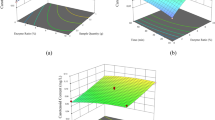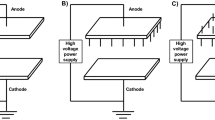Abstract
The flesh browning that appears during commercialization period is the main postharvest disorder that is limiting the market of “Rojo Brillante” persimmon in the Mediterranean area. Previous studies have suggested that mechanical damage suffered by the fruit during packing line operations is the trigger of this alteration when fruit is previously subjected to the required deastringecy treatment. In the present work, the effect of hot water treatments (HWTs) on flesh browning incidence of Rojo Brillante persimmon has been investigated. For that, fruits submitted to the commercial deastringency treatment were hot water treated at 45 °C for 30 min or 50 °C for 20 min and then subjected to different intensity of mechanical damage in packing line. Fruit bathed at 25 °C for 25 min and fruit hand-packed acted as control treatments. Our results confirmed that mechanical damage during packing is a decisive factor in the incidence of flesh browning, and this alteration is found to increase the damage intensity. HWTs significantly alleviated flesh browning disorder by affecting the antioxidative system enzymes; the activity of catalase and ascorbate peroxidase was increased by HWTs while the activity of peroxidases was reduced. No changes were observed in polyphenol oxidase and phenylalanine ammonia lyase activity. Therefore, the application of HWTs may be a useful postharvest technology to reduce flesh browning of persimmon induced by packing line operations.



Similar content being viewed by others
References
Besada, C., Arnal, L., Salvador, A., & Martinez-Javega, J. M. (2010). Flesh browning of persimmon caused by mechanical damage in packing line. Acta Horticulturae, 877, 555–560.
Besada, C., & Salvador, A. (2011). Postharvest handling of persimmon fruit. In A. S. Awaad, G. Kaushik, & J. N. Govil (Eds.), Mechanism and action of phytoconstituents (pp. 111–137). India: Studium Press Pvt. Ldt.
Besada, C., Salvador, A., Arnal, L., & Martinez-Javega, J. M. (2008). Hot water treatment for chilling injury reduction of astringent ‘Rojo Brillante’ persimmon at different maturity stages. HortSci, 43, 2120–2123.
Besada, C., Vazquez-Gutierrez, J. L., Hernando, I., Perez-Munuera, I., & Salvador, A. (2012) Involvement of antioxidant activity in flesh browning of astringent persimmon. Acta Horticulture. in press
Bradford, M. (1976). A rapid and sensitive method for the quantitation of microgram quantities of protein utilizing the principle of protein-dye binding. Annu Rev Biochem, 72, 248–254.
Chang, H., Siegel, B. Z., & Sigel, S. M. (1984). Salinity induced changes in isoperoxidase in taro, Colocasia esculenta. Phytochemistry, 23, 233–235.
Chen, G., & Asada, K. (1989). Ascorbate peroxidase in tea leaves: occurrence of two isozymes and differences in their enzymatic and molecular properties. Plant Cell Physiology, 30, 987–998.
Du, Z., & Bramlage, W. J. (1994). Superoxide dismutase activities in senescing apple fruit (Malus domestica Borkh.). J Food Sci, 59, 581–589.
Duan, X., Liu, T., Zhang, D., Su, X., Lin, H., & Jiang, Y. (2011). Effect of pure oxygen atmosphere on antioxidant enzyme and antioxidant activity of harvested litchi fruit during storage. Food Res Int, 44, 1905–1911.
Falguera, V., Sánchez-Riaño, A. M., Quintero-Cerón, J. P., Rivera-Barrero, C. A., Méndez-Arteaga, J. J., & Ibarz, A. (2011). Characterization of polyphenol oxidase activity in juices from 12 underutilized tropical fruits with high agroindustrial potential. Food and Bioprocess Technology. doi:10.1007/s11947-011-0521-y.
Fallik, E. (2004). Pre-storage hot water treatments (immersion, rinsing and bruising). Postharvest Biology and Technology, 32, 125–134.
Jiang, Y., & Joyce, D. C. (2003). ABA effects on ethylene production, PAL activity, anthocyanin and phenolic contents of strawberry fruit. Plant Growth Regulation, 39, 171–174.
Kamdee, C., Ketsa, S., & vanDoorn, W. G. (2009). Effect of heat treatment on ripening and early peel spotting in cv. Sucrier banana. Postharvest Biology and Technology, 52, 288–293.
Kim SJ, Jung KM (2011). Effects of the PPO (polyphenol oxidase) activity and total phenolic contents on browning and quality of dried-persimmon according to maturity degree of astringent persimmon (Diospyros kaki Thunb.). 2nd International Conference on Biotechnology and Food Science, 115–118.
Lee, H. J., Kim, T. C., Kim, S. J., & Park, S. J. (2005). Bruising injury of persimmon (Diospyros kaki cv. Fuyu) fruits. Sci Hortic, 103, 179–185.
Li, J., Yan, J., Wang, J., Zhao, Y., Cao, J., & Jiang, W. (2010). Effects of chitosan coating on oxidative stress in bruised Yali pears (Pyrus bretschneideri Rehd.). Int J Food Sci Technol, 45, 2149–2154.
Lichanporn, I., Srilaong, V., Wongs-Aree, C., & Kanlayanarat, S. (2009). Postharvest physiology and browning of longkong (Aglaia dookkoo Griff.) fruit under ambient conditions. Postharvest Biology and Technology, 52, 294–299.
Lurie, S. (1998). Postharvest heat treatments. Postharvest Biology and Technology, 14, 257–269.
Martino, G. D., Vizovitis, K., Botondi, R., Bellincontro, A., & Mencarelli, F. (2006). 1-MCP controls ripening induced by impact injury on apricots by affecting SOD and POX activities. Postharvest Biology and Technology, 39, 38–47.
Martinez, M. V., & Whitaker, J. R. (1995). The biochemistry and control of enzymatic browning. Trends Food Sci Technol, 6, 195–200.
Mishra, N. P., Mishra, R. K., & Singhal, G. S. (1993). Changes in the activities of anti-oxidant enzymes during exposure of intact wheat leaves to strong visible light at different temperatures in the presence of protein synthesis inhibitors. Plant Physiol, 102, 903–910.
Mittler, R. (2002). Oxidative stress, antioxidants and stress tolerance. Trends Plant Sci, 7, 405–410.
Park, Y. M., & Lee, Y. J. (2008). Induction of modified atmosphere-related browning disorders in ‘Fuyu’ persimmon fruit. Postharvest Biology and Technology, 47, 346–352.
Pérez-Gago, M. B., Del Río, M. A., Argudo, C., & Mateos, M. (2009). Reducing enzymatic browning of fresh-cut persimmon cv. ‘Rojo Brillante’ by antioxidant application. Acta Horticulturae, 833, 245–250.
Promyou, S., Ketsa, S., & vanDoorn, W. G. (2008). Hot water treatments delay cold-induced banana peel blackening. Postharvest Biology and Technology, 48, 132–138.
Promyo, K., & Park, Y. (2009). Shelf life of non-astringent ‘Fuyu’ persimmon by preheating and hot water dipping with antibrowning agent following cold storage. Hortic Environ Biotechnol, 50, 437–445.
Rao, M. V., Watkins, C. B., Brown, S. K., & Weeden, N. F. (1998). Active oxygen species metabolism in ‘White Angel’ × ‘Rome Beauty’ apple selections resistant and susceptible to superficial scald. J Am Soc Hortic Sci, 123, 299–304.
Richard-Forget, F. C., & Gauillard, F. A. (1997). Oxidation of chlorogenic acid, catechins, and 4-methylcatechol in model solutions by combinations of pear (Pyrus communis cv. Williams) polyphenol oxidase and peroxidase. J Agric Food Chem, 45, 2472–2476.
Rizhsky, L., Liang, H., & Mittler, R. (2002). The combined effect of drought stress and heat shock on gene expression in tobacco. Plant Physiol, 130, 1143–1151.
Saengnil, K., Lueangprasert, K., & Uthaibutra, J. (2006). Control of enzymatic browning of harvested ‘Hong Huay’ litchi fruit with hot water and oxalic acid dips. Science Asia, 32, 345–350.
Salvador, A., Arnal, L., Besada, C., Larrea, V., Quiles, A., & Pérez-Munuera, I. (2007). Physiological and structural changes during ripening and deastringency treatment of persimmon cv. Rojo Brillante. Postharvest Biology and Technology, 46, 181–188.
Vicente, A. R., Martínez, G. A., Chaves, A. R., & Civello, P. M. (2006). Effect of heat treatment on strawberry fruit damage and oxidative metabolism during storage. Postharvest Biology and Technology, 40, 116–122.
Wang, C. Y. (1995). Effect of temperature preconditioning on catalase, peroxidase, and superoxide dismutase in chilled zucchini squash. Postharvest Biology and Technology, 5, 67–76.
Wang, L., Chen, S., Kong, W., Li, S., & Archbold, D. D. (2006). Salicylic acid pretreatment alleviates chilling injury and affects the antioxidant system and heat shock proteins of peaches during cold storage. Postharvest Biology and Technology, 41, 244–251.
Wang, X., Cai, J., Jiang, D., Liu, F., Dai, T., & Cao, W. (2011). Pre-anthesis high-temperature acclimation alleviates damage to the flag leaf caused by post-anthesis heat stress in wheat. Journal of Plant Physiology, 168, 585–593.
Woolf, A. B., Ball, S., Spooner, J., Lay-Yee, M., Ferguson, I. B., Watkins, C. B., Gunson, A., & Forbes, S. K. (1997). Reduction of chilling injury in the sweet persimmon ‘Fuyu’ during storage by dry air heat treatments. Postharvest Biology and Technology, 11, 155–164.
Zhang, Z., Nakano, K., & Maezawa, S. (2009). Comparison of the antioxidant enzymes of broccoli after cold or heat shock treatment at different storage temperatures. Postharvest Biology and Technology, 54, 101–105.
Acknowledgments
This study has been supported by ‘Conselleria d’ Agricultura of Valencian Community’ and the Spanish ‘Ministerio de Educación y Ciencia’ (Project INIA-RTA 2010-00086-00-00) and feder Program from the EU.
Author information
Authors and Affiliations
Corresponding author
Rights and permissions
About this article
Cite this article
Khademi, O., Salvador, A., Zamani, Z. et al. Effects of Hot Water Treatments on Antioxidant Enzymatic System in Reducing Flesh Browning of Persimmon. Food Bioprocess Technol 6, 3038–3046 (2013). https://doi.org/10.1007/s11947-012-0959-6
Received:
Accepted:
Published:
Issue Date:
DOI: https://doi.org/10.1007/s11947-012-0959-6




